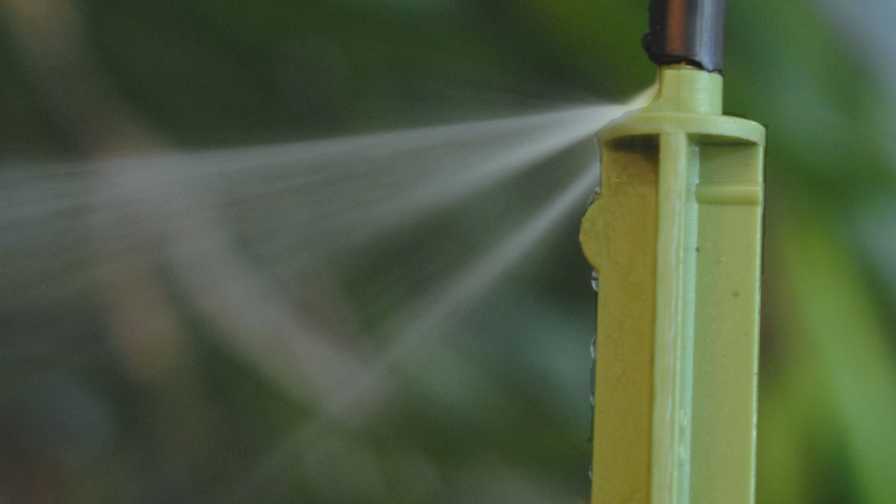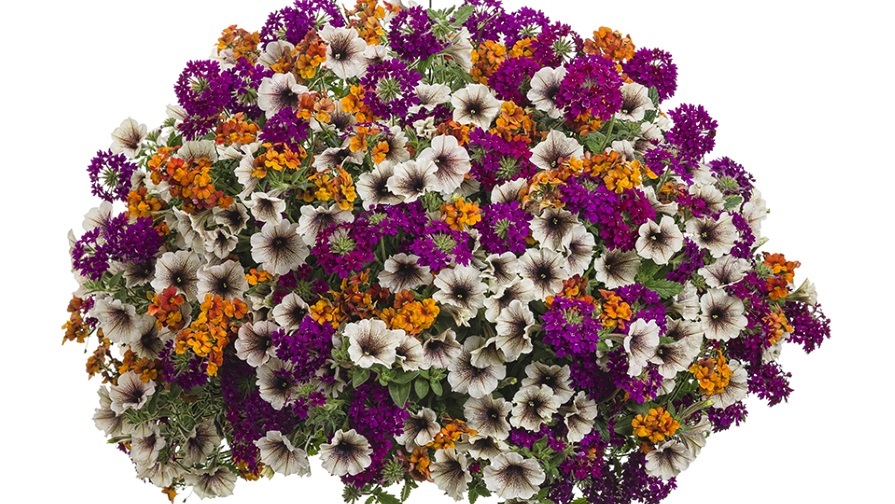Ways To Irrigate Container-Grown Cannabis

Spray stake irrigation is a different concept from drip irrigation. Instead of applying water to a single point, the spray stake has a small container-sized spray pattern that wets all the soil in a container without overspray and promotes full root development. Photo: Grow Irrigation
There are as many ways to grow cannabis as there are uses for the end product. It’s produced in open fields, in hydroponic gardens, and everything in between. However, the most common way to grow cannabis, whether with natural soil or soilless media, is in containers. This is true for indoor grows, greenhouses, and outdoor operations. Container growing offers a combination of control over the root zone environment and operational scalability that’s hard to duplicate with any other method.
There are just as many ways to irrigate cannabis in containers, and if you are a first-time commercial grower, it’s easy to become overwhelmed. Just do a web search on the term “cannabis irrigation” to see the entire confusing array of products and methods people have tried with varying degrees of success. Among these, a few irrigation methods have become mainstream over the past few years because they are precise and effective. This article focuses on these methods as the main options for feeding your plants.
Common Container Types
Before jumping into the details of irrigating cannabis containers, it is worth saying a few words about the containers themselves, as their size and construction has an impact on the irrigation needs of the plants they support.
Cannabis can be grown in conventional plastic containers ranging all the way from 3 to 5 gallons to more than 100 gallons in size. However, cloth-sided pots or corrugated plastic pots are rapidly becoming the methods of choice for experienced cannabis growers. Cloth and corrugated pots have two distinct advantages over conventional plastic: 1) Cloth and corrugated pots are air-permeable, which keeps the root system aerated, providing healthy growing conditions; and 2) Cloth and corrugated pots air prune the roots and prevent plants from becoming root-bound, which can be an unhealthy condition. The combination of these two factors results in faster growing of cannabis plants, especially in the vegetative stages.
It should be noted that irrigation needs to be more frequent with permeable pots then conventional containers because the media is continually drying from all sides. For the same reason, permeable pots also protect plants from root disease that can occur when they are over watered. Growers using light natural soil or soilless media in permeable containers will often run their irrigation systems multiple times per day for very short periods of time. This practice is referred to as high frequency irrigation or pulse irrigation.
Irrigation Options
Cannabis is susceptible to a variety of diseases when its foliage becomes wet. As a result, it is rarely irrigated with overhead sprinklers or sprayers. Also, with the exceptions of light and air, the irrigation system delivers everything that the plant needs to live and thrive including water, fertilizers (organic or inorganic) and micronutrients. Due to both of these factors, irrigation methods for cannabis precisely control water application and keep water at the base of the plants. The leading ones by far are conventional drip irrigation, drip irrigation with distribution rings, and spray stake irrigation.
The best solution for your operation depends on 1) the size of your containers and plants, 2) your growing media, and 3) your tolerance for overspray (water outside of your containers).
Conventional Drip
The conventional way to use drip for irrigating containers is shown in the figure below. A polyethylene supply tube, usually a half-inch or ¾-inch in size, runs along the row, and at each container a pressure compensating dripper is plugged into the supply tube. A small spaghetti tube is connected to the output of the dripper, and its other end is connected to a drip stake, which is placed into the growing media in the container. The function of the drip stake is simply to hold the tubing in place at the right point in the container. It’s a plastic stake about 6 inches long and has a barb on the top to connect tubing to. Depending on the application, a single dripper can supply one, two, four, or more individual drip stakes.
Most of the technology of a drip irrigation system is contained in the pressure compensating dripper. For cannabis growing, the dripper should be a Compensating Non-Leak (CNL) device.
In this term, compensating means that it compensates for pressure variations within the supply line. That is, the dripper will produce the same precise drip rate at its output regardless of the pressure in the supply line, as long as it remains between 15 and 60 psi. For example, if you have a long supply line, the pressure at the end of the line may be lower than the pressure at the beginning of the line which is closer to your water supply. With compensation, all drippers output the same flow rate even with these pressure differences.
Non-Leak means that the dripper only outputs water when supply line pressure is above 10 psi. When CNL emitters are used, all emitters in your irrigation zone turn on simultaneously when pressure is applied, then emit water at exactly the right drip rate. When pressure is removed, they all turn off simultaneously. If drippers without a CNL feature are used, when water is initially turned on, some drippers will flow and some will not as the supply tube fills with water. When the system is turned off, the entire volume of water in the supply tube will drain through the drippers at the lowest point on the row, overwatering those plants. CNL eliminates fill-up and drainage problems and is ideal for high frequency irrigation.
Using CNL drippers, the timing and the amount of water you apply to your plants is precise and completely controllable. Most growers simplify the installation process by using drip assemblies, which includes spaghetti tube that is pre-cut to the right length and already connected to drip stakes on one end, and a connector which attaches to a dripper on the other. Simply add the dripper with the right flow rate and you’re up and running. Some drip assemblies connect two, four, or even more drip stakes to a single dripper, which allows you to water multiple containers, or multiple points in a single container, with a single dripper. Multi-outlet drip assemblies typically connect to Nipple-Outlet CNL drippers, which are CNL drippers with outlet connections designed to be used with an Assemblies.
The main benefits of drip irrigation for cannabis are 1) Total control of timing and amount of water applied (drip is precise); 2) All water goes into the container (no water is lost to misting, evaporation, or overspray); and 3) Liquid nutrients can be applied through your drip system. The biggest disadvantage of drip irrigation is coverage. A drip stake applies water at a single point and may not wet your entire root zone. If you are using light soil, or high contents of ingredients such peat or coco coir, water will go straight to the bottom of the container without wetting the entire root zone. This can be mitigated with multiple stakes per container, but for containers over 5 to 7 gallons with light media, other solutions should be considered.
A secondary disadvantage is that small passageways within drippers can become clogged by water containing high loadings of organic fertilizers or other contaminants. Once a dripper is clogged, it is difficult or impossible to unclog, and it must be replaced. Be sure to use proper filtration and understand what you will be putting through your system.
Drip Distribution Rings
A drip ring, such as the Netafim NetBow shown in the picture to the left, is a variation on conventional drip that provides better coverage in containers up to 12 gallons. The NetBow is a 10-in h plastic ring containing eight drip points that encircles the stock of the plant. Each NetBow connects to a CNL Dripper installed on the supply line through a length of spaghetti tubing. When pressure is applied to the system, the NetBow emits a uniform 10-inch diameter ring of water around the base of the plant to wet a greater portion of its root zone.
Since Drip Rings are a variation of conventional drip irrigation, they share many of the same benefits and drawbacks. While drip rings provide improved coverage, they are still not effective in containers over 12 gallons. For large containers, you still need to look to other forms of irrigation such as spray stakes. Also, drip rings share the same potential clogging problems as conventional drip, and they are expensive in comparison with other methods.
Spray Stakes
Spray stake irrigation is a different concept from drip. Instead of applying water to a single point, the spray stake has a small container-sized spray pattern that wets all the soil in a container without overspray and promotes full root development. Spray Stakes were initially developed for ornamental plant nurseries and are still the most common form of irrigation for that application. Over the years, they have been adopted by cannabis growers, who face some of the same challenges as nursery growers. Today, spray stakes are a major form of irrigation for cannabis and hemp growing.
Typically, a spray stake is placed near the edge of the container with the spray pointed toward the plant. The spray pattern is low enough (about 1 inch above the soil surface) to avoid disease-promoting wetting of the foliage. Spray stakes are available in a variety of flow rates targeted for different container sizes. Containers up to 20 gallons can easily be irrigated with a single spray stake, and very large containers may require multiple spray stakes. For example, a 200-gallon container can be irrigated by four high-flow stakes.
Spray stakes are available in a range of sizes and spray patterns depending on the brand and models. Standard spray stakes are about 5 inches long and are used in containers from 1 to 100-plus gallons. The spray direction is horizontal, parallel to the soil surface, to cover a relatively wide area and ensure the entire soil surface is covered. In smaller containers, the spray will hit the wall of the opposite side of the container, but all of the water remains in the container.
Downspray stakes have a pattern that is pointed downward at a 45-degree angle. This helps ensure all of the water stays inside of the pot without overspray. Downspray stakes are useful in some small-container indoor applications where overspray absolutely cannot happen, or with containers that do not have a lip above the soil to deflect overspray back into the container.
Finally, oversize spray stakes, up to 12 inches long, are available to provide extra stability in light media. In very large containers they can be placed with the head up to 5 inches above the soil surface for a larger spray pattern.
By themselves, most spray stakes are non-compensating. Each zone supplying spray stakes should include a pressure regulator to ensure pressure to the spray stakes stays within their specified range of 15 to 25 psi.
Spray stakes can also have CNL functionality by combining them with very high-flow CNL drippers specially designed for spray stakes. Some spray stake manufacturers supply assemblies made up of a CNL dripper matched to the flow rate of the stake, assembled to a pre-cut length of spaghetti tubing. Simply punch the dripper end of the assembly into your supply tube, put the other end on a spray stake, and you have a high-precision CNL spray stake.
Using a spray stake with CNL functionality delivers the precision of a CNL device along with a spray pattern with full container coverage. It’s a great solution for cannabis in mid to large size containers.
The main benefits of spray stake irrigation for cannabis are:
- Total control of timing and amount of water applied if a CNL device is used.
- Good control of water delivery and low cost if used without a CNL device.
- All water goes into the container. No water is lost to misting or evaporation. No water is lost to overspray in carefully designed systems with larger containers.
- Liquid nutrients can be applied through your system.
The main drawback of spray stake irrigation is that in some small-container operations, it is impossible to completely eliminate overspray. In an indoor application with small (less than 5 gallon) containers where overspray is highly undesirable, drip may be a better solution.
Learn more at GrowIrrigation.com.










